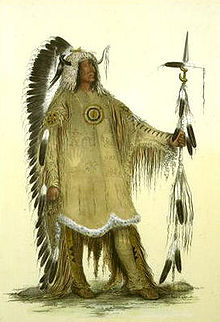
Mato-tope
Encyclopedia

Missouri River
The Missouri River flows through the central United States, and is a tributary of the Mississippi River. It is the longest river in North America and drains the third largest area, though only the thirteenth largest by discharge. The Missouri's watershed encompasses most of the American Great...
in what is now North Dakota
North Dakota
North Dakota is a state located in the Midwestern region of the United States of America, along the Canadian border. The state is bordered by Canada to the north, Minnesota to the east, South Dakota to the south and Montana to the west. North Dakota is the 19th-largest state by area in the U.S....
. Four Bears was a favorite subject of artists, painted by George Catlin
George Catlin
George Catlin was an American painter, author and traveler who specialized in portraits of Native Americans in the Old West.-Early years:...
and Karl Bodmer
Karl Bodmer
Karl Bodmer was a Swiss painter of the American West. He accompanied German explorer Maximilian zu Wied-Neuwied from 1832 through 1834 on his Missouri River expedition...
. Among his people he was a brave warrior, famous for killing a Cheyenne
Cheyenne
Cheyenne are a Native American people of the Great Plains, who are of the Algonquian language family. The Cheyenne Nation is composed of two united tribes, the Só'taeo'o and the Tsétsêhéstâhese .The Cheyenne are thought to have branched off other tribes of Algonquian stock inhabiting lands...
chief in hand to hand combat. He became friends with artist Karl Bodmer
Karl Bodmer
Karl Bodmer was a Swiss painter of the American West. He accompanied German explorer Maximilian zu Wied-Neuwied from 1832 through 1834 on his Missouri River expedition...
in 1833, and became chief in the year 1836. Around that time, a smallpox
Smallpox
Smallpox was an infectious disease unique to humans, caused by either of two virus variants, Variola major and Variola minor. The disease is also known by the Latin names Variola or Variola vera, which is a derivative of the Latin varius, meaning "spotted", or varus, meaning "pimple"...
epidemic wiped out most of his tribe, leaving 125 survivors out of a population of formerly 1,600. He died on July 30, 1837 after suffering from smallpox, brought to his tribe by whites. Before his own death he lost his wife and children to the disease and in his last speech to the Arikara
Arikara
Arikara are a group of Native Americans in North Dakota...
and Mandans (two closely related tribes) he denounced the white man he had previously treated as a brother for bringing the disease to his people. Four Bears lamented that in death his scarred face would be so ugly even the wolves would turn away from him. Smallpox wiped out more than 80 percent of the Mandan population in only a few months, and they were not the only tribe to suffer from the disease. Many believed that he died of smallpox, but George Catlin
George Catlin
George Catlin was an American painter, author and traveler who specialized in portraits of Native Americans in the Old West.-Early years:...
claimed that he starved himself to death out of grief from the death of his family.
Source
http://www.juntosociety.com/native/mandans.htm

